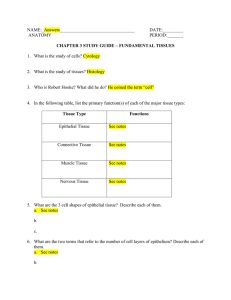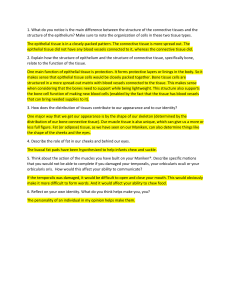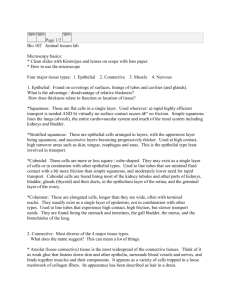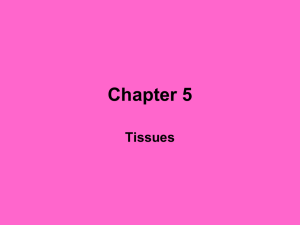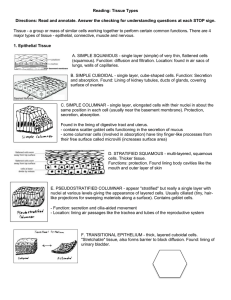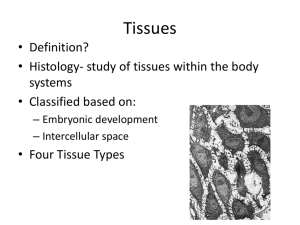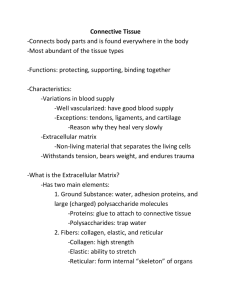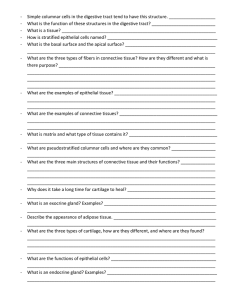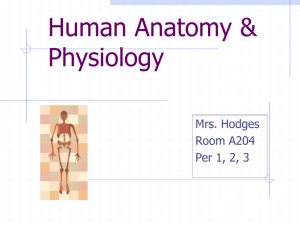File
advertisement
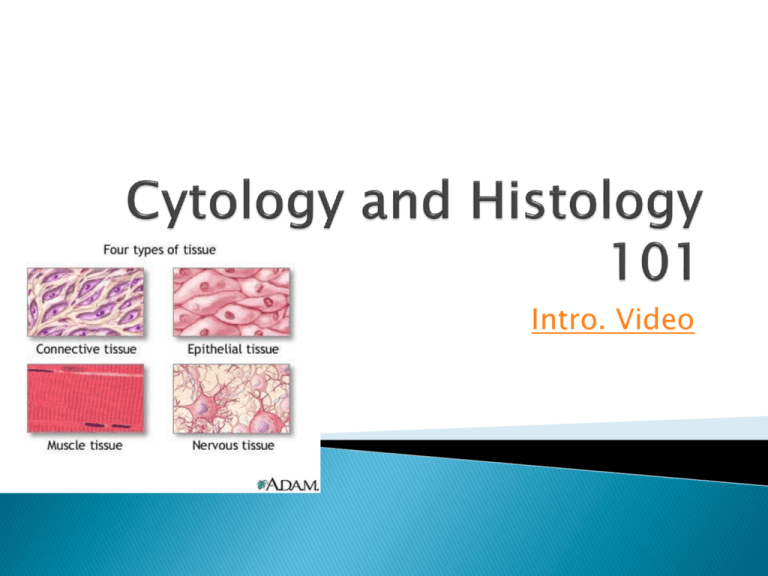
Intro. Video Epithelial Tissue = lining or covering of the body Function = Protection, absorption, filtration and secretion. fits closely together to form continuous sheets. Always have one free surface or edge. (apical) Basement membrane = what the lower surface rests upon (usually connective tissue) No blood supply at all. Rely on diffusion!!! Regenerate easily. Simple = one layer Stratified = more than one layer A. Squamous= flattened “scale” DRAW ONE HERE! b. cuboidal = dice shaped DRAW ONE HERE! c. columnar … DRAW ONE HERE! d. Simple squamous found in lungs and blood vessels. Easy diffusion! Simple cuboidal found in glands and Simple cuboidal found in Goblet cells/ digestive system Psuedostatified columnar found in the respiratory tract have cilia. Statified sqaumous found in areas of friction like the epidermis and mouth. Transitional epithleial found in organs that stretch like urinary bladder. Glandular = one or more cells that make or secrete a product. Secretion = protein molecules in a water based fluid MUCUS) for protection! Endocrine gland =ductless Exocrine = have ducts Function: Protect, support and bind together, store fat, produce blood cells, repair and protect against infection. a. vary in blood supply and are farther apart than epithelial. b. Extracellular matrix can hold more weight & stretch more. Collagen = white… resist pulling, elastic = light yellowish ex. tendons (bone to muscle) and ligaments (bone to bone) reticular = very fine fibers ex. = spleen Macrophages – eat forgien particles Mast cells - release proteins that help prevent blood clots and stop allergic reactions. Fibroblasts—most common connective tissue, star shaped and secrete protein into extracellular matrix. Loose Connective – flexible Areolar—most abundant, delicate, thin and elastic, provides a soft cushion ex. collagen Adipose - FAT, cushions, insulates and protects organs. Reticular- interwoven like blood cells in spleen Dense Connective- not so flexible Cartilage – rigid, protects and attaches Most common is hyaline cartilage ex. larynx Elastic- ex. ear Fibrocartilage – very tough ex. discs btwn.vertebrae Bone-- most rigid connective tissue, due to mineral salts Blood-- transports a variety of materials through body and external environment. Serous-- line the body cavities and lack opening to outside body, have a watery fluid that lubricates. Mucous-- line cavities open to outside the body. Ex. nose and mouth Cutaneous—a.k.a. the SKIN Synovial – lines the joints. Function = movement . Consists of long fibers that contract or shorten. Smooth / Involuntary = have no striations and elongated nuclei. Found in the walls of organs. Skeletal = attached to bone. Control voluntary actions. Have obvious striations (light and dark cross markings). Cardiac = found only in the heart. Fit together closely, each has their own nuclei so that ions can move quickly and heart can contract often. Function = control body! Parts include brain, spinal cord and nerves. Have neuroglial cells that help neurons communicate. Regeneration = replacement of cells. Ex. epithelial and connective Fibrosis = scar tissue. Ex. Muscle & nervous **** Scar tissue does not function like the original tissue!! Video When cells regenerate wildly = neoplasm. a. Benign = grow slowly ( not harmful) b. malignant = grow quickly cancerous! Hyperplasia = increase in # of cells and is caused by a local irritant Atrophy = decrease in # of cells if it not used Growth through cell division occurs from conception to puberty. Cells exposed to friction will continue to reproduce- like your skin. Connective tissue remains mitotic. Heart and nervous tissue becomes amitotic. (unable to reproduce) ex. heart attacks cause scar tissue = can’t contract as well. Cause of aging is unknown. As we age, our muscles weaken, epithelium becomes thinner, skin loses elasticity and our exocrine glands dry out! BET YOU CAN’T WAIT! Ha Ha!

